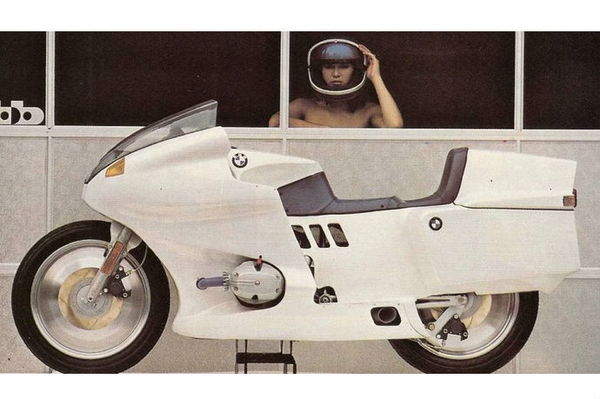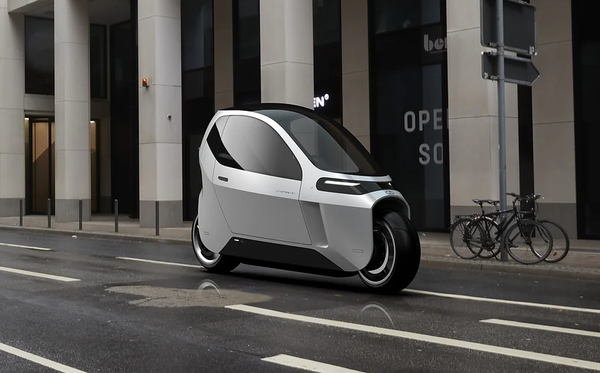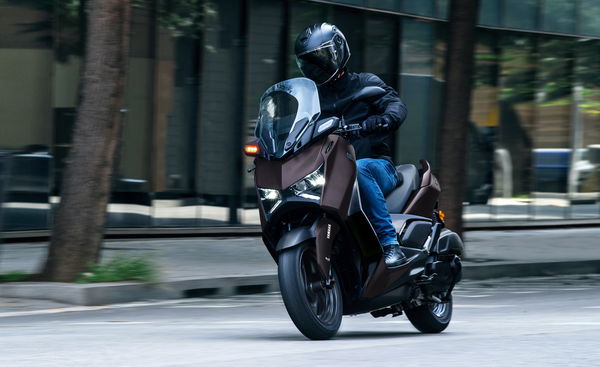Top 10 BMW innovations
After 100 years, what has BMW ever done for us?

This year marks the centenary of Bayerische Motoren Werke AG so we’re looking back at the company’s motorcycling innovations to list the top 10 motorcycling firsts that the firm has achieved in as many decades.
Until fairly recently BMW’s mainstream motorcycling image was one of staid solidity rather than spectacular blue-sky thinking, but looking back at the company’s achievements it’s clear that reputation was ill-deserved. It might have long steered clear of the crucible of superbike racing and avoided direct comparison with other firms, but BMW has been ploughing its own innovative furrow ever since it first started building bikes in the 1920s.
Some of the technologies that it’s brought to the market have remained BMW-only oddities while others have spread so far and wide it’s hard to imagine motorcycle design without them. Rather than trying to rank one innovation above another, we’re listing them chronologically.
10. 1935 BMW R12 - hydraulically-damped telescopic forks
For the last couple of decades BMW has had a reputation for unconventional front suspension set-ups – Telelever and Duolever – but the firm was also the first to bring a bike with hydraulically-damped telescopic forks to the market. The 1935 R12 was the machine in question. While others, notably Scott, had tried telescopic forks in the past, they’d been undamped until the BMW turned up. So on this occasion, BMW’s decision to use ‘unconventional’ front suspension laid the template for almost every motorcycle of the modern era.
��
9. 1973 BMW R90S - nose fairing
The Hans Muth-designed R90S is remembered for many things, not least its two-tone paintwork, but while fairings had long been familiar on racing bikes it was particularly notable as being the first mass-made production machine with such bodywork. Of course, even on the road fairings weren’t unfamiliar by the time the R90S was launched, but they were generally aftermarket additions rather than standard equipment. There had been small-scale, exotic bikes offered with wind protection – the Vincent Black Prince and Black Knight spring to mind – but the R90S nosecone was arguably the one that brought bodywork to the mainstream.
8. 1977 R100RS - first full fairing on a production bike
The R90S nose fairing might have been effective but it was only a toe-in-the-water exercise. The R100RS’s full bodywork, which included side panels and a belly pan and was rigidly mounted to the frame instead of turning with the bars, was the real leap to full fairings as we know them today. It was Hans Muth responsible for the styling again, although this time he was assisted by a wind-tunnel.
7. 1980 R80 GS - first big trailie and first single-sided swingarm
While the modern adventure bike craze didn’t really take off until the last decade BMW has been punting machines in the category since 1980 when the R80 G/S effectively created the class. With G/S standing for ‘Gelände/Strasse’ or ‘Off-road/Street’ it was the first large-capacity, multi-cylinder machine aimed at having off-road ability and long-distance touring appeal. It quickly made its name on events like the Paris-Dakar Rally. Less well-known is that it was the first mainstream machine to come with a single-sided swingarm.
6. 1980 Futuro - First modern concept bike
Barely a year goes past these days without a crop of concept bikes form major firms previewing future styling directions or technical trends. Or, a cynic might suggest, simply trying to draw attention to an otherwise lacklustre show stand. But BMW’s Futuro was the first to do it. Given that aerodynamic efficiency was high on BMW’s list of priorities at the time, the bike’s bullet-like shape should be no surprise, along with its disc wheels. But the Futuro also sported a turbo version of the firm’s boxer twin – pre-empting the turbo trend of the 80s and reflecting the availability of aftermarket BMW turbo kits. It also featured a monocoque frame and unusual parallelogram rear suspension that pre-empted the Paralever arrangement that would appear on the firm’s production models many years later.
5. 1987 K100 - ABS brakes
ABS might just be starting to become mainstream (and compulsory on new bikes from next year) but it dates back nearly three decades on the BMW K-series. The original version was the Bosch ABS-1. We’re onto the tenth-generation ABS-10 now, but the principle remains the same. Back then, the ABS had that trademark pulsing feel that’s largely been eliminated in much faster-acting modern systems, but it still worked.
4. 1988 R100GS - first Paralever rear suspension
Given BMW is a car firm as well as a motorcycle maker it shouldn’t be a surprise that some car-influenced ideas make their way across to two wheels. Paralever, which adds a second link to the rear suspension and, along with the drive shaft, creates a parallelogram shape, is one. On the bike, it helps prevent the shaft drive reaction that would, on a normal shaft-drive system, make the rear end jack up under acceleration. In fact Paralever goes further, allowing BMW to balance the shaft-drive jacking effect against the rearward weight transfer and resulting squat that you’d expect to get under acceleration. The K1 also gained Paralever in 1988, becoming the first four-cylinder BMW with the system.
3. 1993 R1100RS - first Telelever front suspension
Having been first off the mark with hydraulically-damped telescopic forks, BMW’s decision to move on to a different system might have become a turning point for bike design as a whole. It didn’t end up that way, but more than 20 years on Telelever is still going strong on many of the firm’s bikes. In fact, it’s a development of the British Saxon-Motodd idea, which combined a telescopic fork with a separate wishbone and spring/damper unit. It cuts down the stress at the steering head, transfers braking forces to a beefier part of the frame, reduces unspring weight and keeps a more constant wheelbase than a normal telescopic fork. Telelever was the first chance for many riders to experience anything other than a normal telescopic fork and its success is perhaps best measured by the fact that the system feels remarkably ‘normal’ even if you’ve never ridden with it before.
2. 2004 K1200S - first Duolever suspension
Norman Hossack’s tireless effort to create a suspension system better than conventional front forks resulted in a system with two car-style wishbones connected to an upright that holds the wheel and was proven in racing back in the 1980s. BMW took note and tested Hossack’s system not long afterwards but it took until 2004 for it to reach production. The firm still uses it today, making it the only mainstream manufacturer to offer something significantly different to telescopic forks, and it works well. There were even plans to use Duolever on the S1000RR, and during its development a Suzuki GSX-R1000 was modified as a Duolever superbike testbed. Eventually the firm opted for telescopic technology – perhaps as much as anything because superbike buyers and race teams were more comfortable with teles – but Duolever is likely to be around for a long time yet.
1. 2016 C650 - Side View Assist
In recent years many of BMW’s innovations and firsts have been electronic. We considered including the Gear Shift Assist Pro system here, allowing clutchless up and down shifts, as it’s certainly influential and likely to be followed by many of the firm’s rivals. But the Side View Assist option of the latest C650 scooters might actually be more important and it’s a technology that BMW has a clear head start on. It basically takes car technology in the form of a sensor that tells if there’s anything in your blind spot and lights up an alert on the relevant mirror. It’s simple and could easily be implemented on other bikes – in fact it surely will be. It’s not quite as transformative as ABS, but shows BMW is still at the leading edge when it comes to bringing new ideas onto two wheels.
�
This year marks the centenary of Bayerische Motoren Werke AG so we’re looking back at the company’s motorcycling innovations to list the top 10 motorcycling firsts that the firm has achieved in as many decades.
Until fairly recently BMW’s mainstream motorcycling image was one of staid solidity rather than spectacular blue-sky thinking, but looking back at the company’s achievements it’s clear that reputation was ill-deserved. It might have long steered clear of the crucible of superbike racing and avoided direct comparison with other firms, but BMW has been ploughing its own innovative furrow ever since it first started building bikes in the 1920s.
Some of the technologies that it’s brought to the market have remained BMW-only oddities while others have spread so far and wide it’s hard to imagine motorcycle design without them. Rather than trying to rank one innovation above another, we’re listing them chronologically.
10. 1935 BMW R12 - hydraulically-damped telescopic forks
For the last couple of decades BMW has had a reputation for unconventional front suspension set-ups – Telelever and Duolever – but the firm was also the first to bring a bike with hydraulically-damped telescopic forks to the market. The 1935 R12 was the machine in question. While others, notably Scott, had tried telescopic forks in the past, they’d been undamped until the BMW turned up. So on this occasion, BMW’s decision to use ‘unconventional’ front suspension laid the template for almost every motorcycle of the modern era.
�
9. 1973 BMW R90S - nose fairing
The Hans Muth-designed R90S is remembered for many things, not least its two-tone paintwork, but while fairings had long been familiar on racing bikes it was particularly notable as being the first mass-made production machine with such bodywork. Of course, even on the road fairings weren’t unfamiliar by the time the R90S was launched, but they were generally aftermarket additions rather than standard equipment. There had been small-scale, exotic bikes offered with wind protection – the Vincent Black Prince and Black Knight spring to mind – but the R90S nosecone was arguably the one that brought bodywork to the mainstream.
�
8. 1977 R100RS - first full fairing on a production bike
The R90S nose fairing might have been effective but it was only a toe-in-the-water exercise. The R100RS’s full bodywork, which included side panels and a belly pan and was rigidly mounted to the frame instead of turning with the bars, was the real leap to full fairings as we know them today. It was Hans Muth responsible for the styling again, although this time he was assisted by a wind-tunnel.
�
7. 1980 R80 G/S - first big trailie and first single-sided swing-arm
While the modern adventure bike craze didn’t really take off until the last decade BMW has been punting machines in the category since 1980 when the R80 G/S effectively created the class. With G/S standing for ‘Gelände/Strasse’ or ‘Off-road/Street’ it was the first large-capacity, multi-cylinder machine aimed at having off-road ability and long-distance touring appeal. It quickly made its name on events like the Paris-Dakar Rally. Less well-known is that it was the first mainstream machine to come with a single-sided swing-arm.
�
6. 1980 Futuro - first modern concept bike
Barely a year goes past these days without a crop of concept bikes form major firms previewing future styling directions or technical trends. Or, a cynic might suggest, simply trying to draw attention to an otherwise lacklustre show stand. But BMW’s Futuro was the first to do it. Given that aerodynamic efficiency was high on BMW’s list of priorities at the time, the bike’s bullet-like shape should be no surprise, along with its disc wheels. But the Futuro also sported a turbo version of the firm’s boxer twin – pre-empting the turbo trend of the '80s and reflecting the availability of aftermarket BMW turbo kits. It also featured a monocoque frame and unusual parallelogram rear suspension that pre-empted the Paralever arrangement that would appear on the firm’s production models many years later.
�
5. 1987 K100 - ABS brakes
ABS might just be starting to become mainstream (and compulsory on new bikes over 125cc from next year) but it dates back nearly three decades on the BMW K-series. The original version was the Bosch ABS-1. We’re onto the tenth-generation ABS-10 now, but the principle remains the same. Back then, the ABS had that trademark pulsing feel that’s largely been eliminated in much faster-acting modern systems, but it still worked.
�
4. 1988 R100GS - first Paralever rear suspension
Given BMW is a car firm as well as a motorcycle maker it shouldn’t be a surprise that some car-influenced ideas make their way across to two wheels. Paralever, which adds a second link to the rear suspension and, along with the drive shaft, creates a parallelogram shape, is one. On the bike, it helps prevent the shaft drive reaction that would otherwise make the rear end jack up under acceleration. In fact Paralever goes further, allowing BMW to balance the shaft-drive jacking effect against the rearward weight transfer under acceleration. The K1 also gained Paralever in 1988, becoming the first four-cylinder BMW with the system.
�
3. 1993 R1100RS - first Telelever front suspension
Having been first off the mark with hydraulically-damped telescopic forks, BMW’s decision to move on to a different system might have become a turning point for bike design as a whole. It didn’t end up that way, but more than 20 years on Telelever is still going strong on many of the firm’s bikes. In fact, it’s a development of the British Saxon-Motodd idea, which combined a telescopic fork with a separate wishbone and spring/damper unit. It cuts down the stress at the steering head, transfers braking forces to a beefier part of the frame, reduces unspring weight and keeps a more constant wheelbase than a normal telescopic fork. Telelever was the first chance for many riders to experience anything other than a normal telescopic fork and its success is perhaps best measured by the fact that the system feels remarkably ‘normal’ even if you’ve never ridden with it before.
�
2. 2004 K1200S - first Duolever suspension
Norman Hossack’s tireless effort to create a suspension system better than conventional front forks resulted in an arrangement of two car-style wishbones connected to an upright that holds the wheel, proven in racing back in the 1980s. BMW took note and tested Hossack’s system not long afterwards but it took until 2004 for it to reach production. The firm still uses it today, making it the only mainstream manufacturer to offer something significantly different to telescopic forks, and it works well. There were even plans to use Duolever on the S1000RR, and during its development a Suzuki GSX-R1000 was modified as a Duolever superbike test-bed. Eventually the firm opted for telescopic technology – perhaps as much as anything because superbike buyers and race teams were more comfortable with teles – but Duolever is likely to be around for a long time yet.
�
1. 2016 C650 - Side View Assist
In recent years many of BMW’s innovations and firsts have been electronic. We considered including the Gear Shift Assist Pro system here, allowing clutch-less up-and-down-shifts, as it’s certainly influential and likely to be followed by many of the firm’s rivals. But the Side View Assist option of the latest C650 scooters might actually be more important and it’s a technology that BMW has a clear head-start on. It basically takes car technology in the form of a sensor that detects vehicles in your blind spot and lights up an alert on the relevant mirror. It’s simple and could easily be implemented on other bikes. In fact it surely will be. It’s not quite as transformative as ABS, but shows BMW is still at the leading edge when it comes to bringing new ideas to two wheels.











